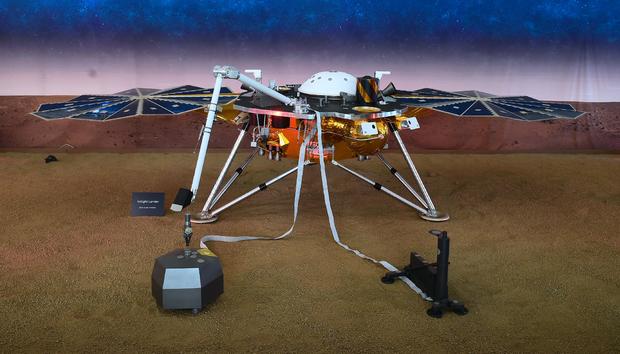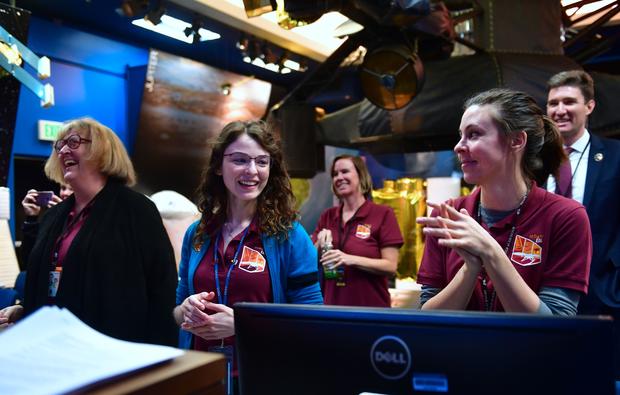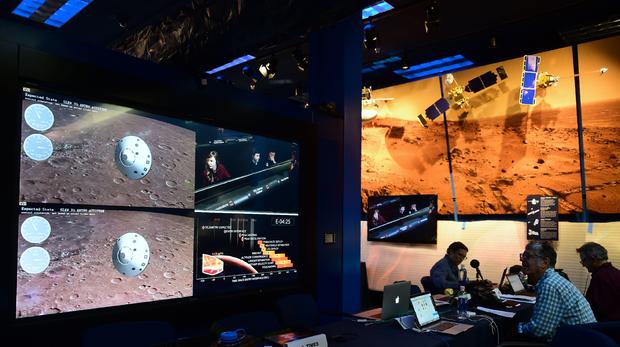InSight Spacecraft Touches Down On Mars
PASADENA (CBSLA/CBS News) – The InSight spacecraft, which took off from California nearly six months ago, finally made its landing on the surface of Mars Monday.
The spacecraft touched down on schedule at 11:54 a.m. Pacific time, sparking cheers and applause at JPL in Pasadena. The craft made a harrowing descent through the Martian atmosphere, with a parachute and retro rockets deployed to cut its speed to a few miles an hour to allow it to safely touch down on the surface.
Minutes later, the craft transmitted its first image from the planet's surface.
The InSight logged 300 million miles to get to the Red Planet since blasting off from Vandenberg Air Force Base near Lompoc aboard an Atlas 5 Rocket on May 5. It marked the first time a Mars lander has ever been launched from the West Coast.
The InSight, which is being managed by Pasadena-based Jet Propulsion Laboratory, is scheduled to land on Mars at around noon Pacific time. To successfully land, Insight must go from about about 12,300 miles per hour to 0 in around six minutes.
"As it burns in the atmosphere, to slow down, it burns the heat shield, there will actually be a communications blackout, where the communications from the spacecraft will not be able to be received here on earth," NASA administrator Jim Bridenstine said. "So, there will be a period of time where there's a blackout, then an eight-minute delay in order to get the signal. But for our perspective here on earth, we're not going to know it."
The InSight mission -- short for Interior Exploration using Seismic Investigations, Geodesy and Heat Transport -- is the first ever dedicated to Mars' deep interior, and it will be the first NASA mission since the Apollo moon landings to place a seismometer on the soil of another celestial body.
The spacecraft is not a rover. It is designed to carry out its mission from a stationary position, and it is expected to land and set up shop in an area known as the Elysium Planitia, which JPL officials dubbed "the biggest parking lot on Mars," providing a flat solid surface for the craft to do its work.
It's still unclear exactly when NASA and JPL officials will be able to confirm that the craft has successfully landed. Confirmation will be made through monitoring of InSight's radio signals by a variety of spacecraft and Earth-based telescopes. But given delays in collecting such information, "the mission team may know right away when InSight touches down, or they may have to wait up to several hours," according to JPL.
As the spacecraft speeds toward Mars and begins descending through the thin atmosphere -- which lacks the type of friction that usually slows landing objects -- a parachute will be deployed and retro rockets will be fired to ease the descent. Suspended legs will also be used to absorb some of the shock.
JPL officials noted that the spacecraft was designed with a durable heat shield that can protect it against a dust storm if necessary while landing.
Once it lands, the spacecraft will send out a confirmation signal, using a "tone beacon" that mission managers hope will be picked up by radio telescopes. Another signal will be sent seven minutes later, this time using a more powerful antenna and transmitting information to indicate if the craft is in a "healthy, functioning state."
InSight is the eighth lander NASA has sent to Mars. Since 1964, the United States has now launched 23 robotic spacecraft to the red planet at a cost of more than $20 billion in an evolving campaign to map out the red planet's surface, determine the role of water in its history and to search for signs of past habitability and the organic building blocks of life.
"The goal of InSight is nothing less than to better understand the birth of the Earth, the birth of the planet we live on, and we're going to do that by going to Mars," Bruce Banerdt, principal investigator of the InSight mission, told CBS News back in May.
"How we get from a ball of featureless rock into a planet that may or may not support life is a key question," he said.
InSight is equipped with two primary instruments: the Seismic Experiment Interior Structure — SEIS — seismometer, provided by the French space agency, CNES, and the Heat Flow and Physical Properties Probe — HP3 — provided by the German Aerospace Agency, DLR. The two instruments cost the European space agencies about $180 million.
After a detailed photo survey of the surrounding terrain near the lander and repeated rehearsals on Earth, a robot arm on InSight's upper deck will be commanded to pick up both instruments and lower them to the surface.
The seismometer "is really the heart of the InSight mission," Banerdt said. "The seismometer is what allows us to see deep into the planet, to have insight into the planet, and it uses the seismic waves that are generated by marsquakes."
The instrument, protected from the elements by a dome-shaped shield, is capable of measuring movements smaller than the width of a hydrogen atom. As seismic waves from marsquakes travel through the martian interior, they will pass through different types of rock and soil that will alter their shape.
The heat probe will use a motor and spring-driven hammer mechanism to pound its way down into the martian soil trailing a cable with sensitive temperature sensors. Pausing along the way to measure the thermal conductivity of the soil at different points, the probe could reach a maximum depth of about 15 feet.
InSight's third investigation relies on the lander's radio system. By carefully analyzing slight changes in the radio signals from the spacecraft as Mars rotates on its axis and sweeps along its orbit, scientists can precisely locate the martian polar axis and measure how it slowly changes orientation.
(© 2018 CBS Interactive Inc. All Rights Reserved. City News Service contributed to this report.)







